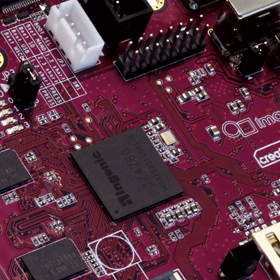The fundamental principle of the build system
=============================================
Assume that we need to build the program or alienated package for working
on the three devices with names ci20, bt01 and dm64. The first two devices
(ci20, bt01) are based on the MIPS architecture, and the third device (dm64)
is built on ARM-based processor. Toolchains for building our program, for
simplicity, let's call mips and arm, respectively.
The build script of the source program is the same for each of our devices
and is written on GNU Make.
If we present all available combinations of command line calls, required for
building the program for our devices, we get:
$ TOOLCHAIN=mips HARDWARE=ci20 make
$ TOOLCHAIN=mips HARDWARE=bt01 make
$ TOOLCHAIN=arm HARDWARE=dm64 make
or (in case when the TOOLCHAIN-HARDWARE pairs are transmitted as arguments):
$ make TOOLCHAIN=mips HARDWARE=ci20
$ make TOOLCHAIN=mips HARDWARE=bt01
$ make TOOLCHAIN=arm HARDWARE=dm64
Thus, the build system must receive a TOOLCHAIN-HARDWARE pair, and then the
build system has to determine which toolchain must be used for a particular
device.
Let us now consider how to organize the sequence of command calls (on the
build system level) in such way that the user can do these actions by
applying only one call:
$ make
without specifying additional arguments which are responsible for selection
of the target device and applicable toolchain.
If we describe the list of valid terget devices at the beginning of our script,
for example, as follows:
COMPONENT_TARGETS = $(HARDWARE_CI20)
COMPONENT_TARGETS += $(HARDWARE_BT01)
COMPONENT_TARGETS += $(HARDWARE_DM64)
then the build system can automatically construct a list of possible
TOOLCHAIN-HARDWARE combinations for a given build script, which will looks
like following:
targets = target_mips_ci20 target_mips_bt01 target_arm_dm64
With such list, the build system can restore arguments which are needed for
each of three our calls. It is very simple to do. On the Make language we can
do it as shown by following lines:
target_%: TOOLCHAIN = $(shell echo $(word 2, $(subst _, , $@)))
target_%: HARDWARE = $(shell echo $(word 3, $(subst _, , $@)))
target_%:
$(MAKE) TOOLCHAIN=$(TOOLCHAIN) HARDWARE=$(HARDWARE)
Thus, if we call the Make utility without arguments then TOOLCHAIN and HARDWARE
variables will be undefined. In this case the build system starts to collect the
targets list. When the targets list will be complete the build system can do the
call
$(MAKE) TOOLCHAIN=$(TOOLCHAIN) HARDWARE=$(HARDWARE)
with valid arguments.
When (at the next call) the system will make sure that the TOOLCHAIN and
HARDWARE variables are defined, the control of the build process will be passed
to our build script without additional calculations.
The described mechanism is directly derived from the GNU Make documentation.
References
----------
http://www.gnu.org/software/make/manual/
http://radix.pro/build-system/
Radix cross Linux Build System
Cross-platform build system is designed to build distributions of different operating systems for a set of target devices
39 Commits
2 Branches
2 Tags
